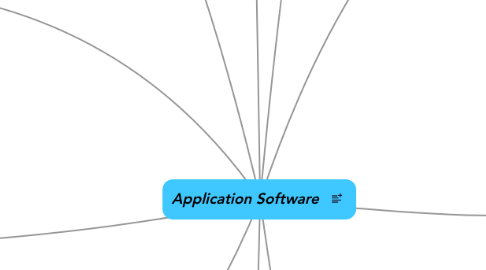Application Software
by anawin saidum


1. Application softwareconsists of programs designed to make users more productive and/or assist with personal tasks
1.1. To make business activities more efficientTo
1.2. To facilitate communications
1.3. To assist with graphics and multimedia projects
1.4. To support home, personal, and educational tasks
2. Objectives Overview
2.1. Identify the four categories of application software
2.2. Differentiate among the seven forms through which software is available
2.3. Explain how the operating system and utility programs work with application software
2.4. Describe characteristics of a user interface
2.5. Identify the key features of widely used business programs
2.6. Identify the key features of widely used graphics and multimedia programs
2.7. Identify the key features of widely used home, personal, and educational programs
2.8. Discuss the advantages of and ways to access Web applications
3. Software for Home, Personal, and Educational Use
3.1. Personal finance software
3.2. Legal software
3.3. Tax preparation software
3.4. Personal DTP software
3.5. Personal paint/image editing software
3.6. Personal photo editing software
3.7. Clip art/image gallery
3.8. Video and audio editing software
3.9. Home design/landscaping software
3.10. Travel and mapping software
3.11. Reference software
3.12. Entertainment software
4. Web Applications
4.1. A Web application is a Web site that allows users to access and interact with software from any computer or device that is connected to the Internet
4.2. Web Browser
4.3. RoomText, Picture, Video Messaging
4.4. E‐Mail
4.5. Instant Messaging
4.6. Chat RoomText
4.7. RSS Aggregator
4.8. Blogging
4.9. Newsgroup/Message Board
4.10. FTP
4.11. FTP Video
5. Learning Tools for Application Software
5.1. Online Helpis the electronic equivalent of a user manual
5.2. You can ask a question or access the Help topics in subject or alphabetical order
5.3. Web‐based Help provides updates and more comprehensive resources to respond to technical issues about software
5.4. Web‐based training is a type of CBT that uses Internet technology and consists of application software on the Web
5.5. Distance learning (DL) is the delivery of education at one location while the learning takes place at other locations
6. Summary
6.1. How to start and interact with application software
6.2. Overview of a variety of business software, graphics and multimedia software, and home/personal/educational software
6.3. Web applications and application software for communications
6.4. Learning tools for application software and Web‐based training
7. Available in a variety of forms
7.1. Packaged software
7.2. Custom software
7.3. Web application
7.4. Open source software
7.5. Shareware
7.6. Freeware
7.7. domain software
8. Business software
8.1. Business software
8.1.1. Word Processing
8.1.2. Spreadsheet
8.1.3. Database
8.1.4. Presentation
8.1.5. Note taking
8.1.6. Personal information manager
8.1.7. Business software for phones
8.1.8. management
8.1.9. Accounting
8.1.10. Document man
8.2. Word processing software
8.3. Clip art
8.4. Additional word processing features include
8.4.1. Columns
8.4.2. Macros
8.4.3. AutoFormat
8.4.4. Collaboration
8.4.5. Grammar
8.4.6. Reading
8.4.7. Smart Tags
8.4.8. Tables
8.4.9. Templates
8.4.10. Thesaurus
8.4.11. Tracking Changes
8.4.12. Web Page Development
8.5. Developing a document
8.5.1. Create a document
8.5.2. Edita document
8.5.3. Formata document
8.6. Spreadsheet software
8.7. Presentation software
8.8. Note taking software
8.8.1. A software suiteis a collection of individual programs available together as a unit
8.8.2. A personal information manager (PIM) is application software that includes
8.8.2.1. Appointment calendar
8.8.2.2. Address book
8.8.2.3. Notepad
